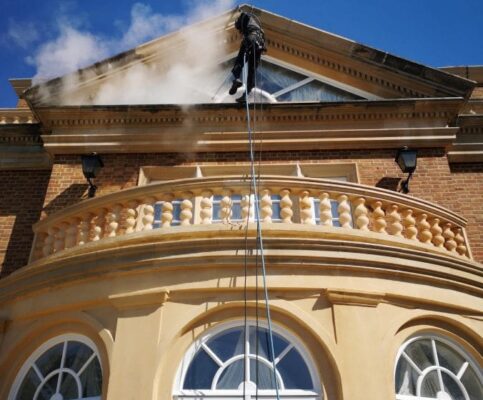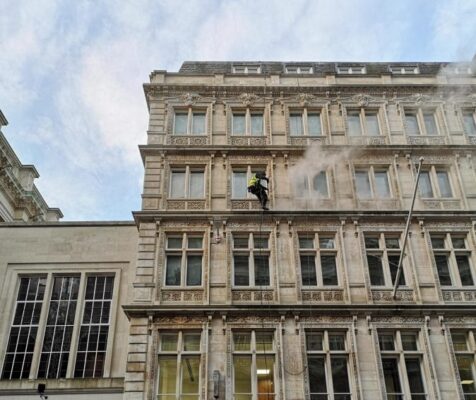View More SErvices Contact Us
Facade Cleaning in Limehouse
Cleaning building facades from top to bottom, no matter how tall your building.
Natural stone facade cleaning in Limehouse can be accessed and cleaned efficiently and effectively by using rope access methods. Using this method, the need for local authority permits is totally eradicated, allowing works to proceed immediately. Using professional stone cleaning equipment we can roll back the years to make your building look like new.
Brick cleaning
Brick buildings become dirty as much as any other building. We will not only clean away the dirt and grime, we can revitalise the colour. Using a range of bio-degradable chemicals, we can restore the colour of red or yellow bricks.
Contact UsGlass facade cleaning in Limehouse
Glass facade cleaning in Limehouse takes place by abseilers using traditional window cleaning tools. External windows, internal atriums, after builders cleaning or regular maintenance cleans, our abseilers are experienced in all manner of glass cleaning.
Contact UsAluminium cladding cleaning
Aluminium cladding in Limehouse can become extremely dirty over time. Warehouses that have many lorries coming and going will become soiled with traffic film. Using our steam cleaning systems, this grime is washed away leaving a lasting first impression for your visitors.
Contact UsOur services
Rope Access Facade Cleaning Services for Limehouse And Surrounding Counties

Residential property Stone Facade Cleaning
Façade cleaning at this residential property in Limehouse, which was not of any great height but, had no access for other forms of access equipment. Abseiling was the solution and the results were outstanding.

Stone Steam Cleaning in London
This beautiful natural stone building was looking tired from the day to day London traffic. Rope access was seen as the most cost-effective method of access.

Concrete Facade Cleaning in Limehouse
This car park in Essex was filthy. It hadn’t been cleaned, ever. As the access to three elevations was extremely tight, abseiling was the only method that could achieve the results.

Facade Cleaning in Limehouse
A new acquisition for our client needed a freshen up. Out of hours abseiling was the best way to clean this building in the heart of the City of London.
Brick colour restoration
Before colour restoration
This client requested a test patch before assigning us the job of cleaning their building. We carried this out with amazing results.
After colour restoration
These are the pictures of the test patch that we sent to the client. Her reaction was simply ‘WOW’. That’s the perfect response for us.
Torik Stone Cleaning System Features
150 degrees centigrade steam cleaning power
Provides a continues flow of superheated water to penetrate stone and deep clean, removing organic growth & ground in dirt.
We use Tensid (uk) Ltd
Providers of specialist cleaning equipment and specialist cleaning chemicals to professionals.
Get In Touch
Fill in the form below and we’ll be in touch within 24hrs of receiving your message.
Facts About Limehouse
Limehouse History
From its foundation, Limehouse, like neighbouring Wapping, has enjoyed better links with the river than the land, the land route being across a marsh. Limehouse became a significant port in late medieval times, with extensive docks and wharves. Although most cargoes were discharged in the Pool of London before the establishment of the docks, industries such as shipbuilding, ship chandlering and rope making were established in Limehouse.
Limehouse Basin opened in 1820 as the Regent’s Canal Dock. This was an important connection between the Thames and the canal system, where cargoes could be transferred from larger ships to the shallow-draught canal boats. This mix of vessels can still be seen in the Basin: canal narrowboats rubbing shoulders with seagoing yachts.
General Info
Limehouse is a district in the London Borough of Tower Hamlets in East London. It is 3.9 miles east of Charing Cross, on the northern bank of the River Thames. Its proximity to the river has given it a strong maritime character, which it retains through its riverside public houses and steps, such as The Grapes and Limehouse Stairs.
It was part of the traditional county of Middlesex, but became part of the County of London following the passing of the Local Government Act 1888, and then part of Greater London in 1965. Located between Stepney to the west and north, Mile End and Bow to the northwest, Poplar to the east, and Canary Wharf and Millwall to the south.



